Featured in
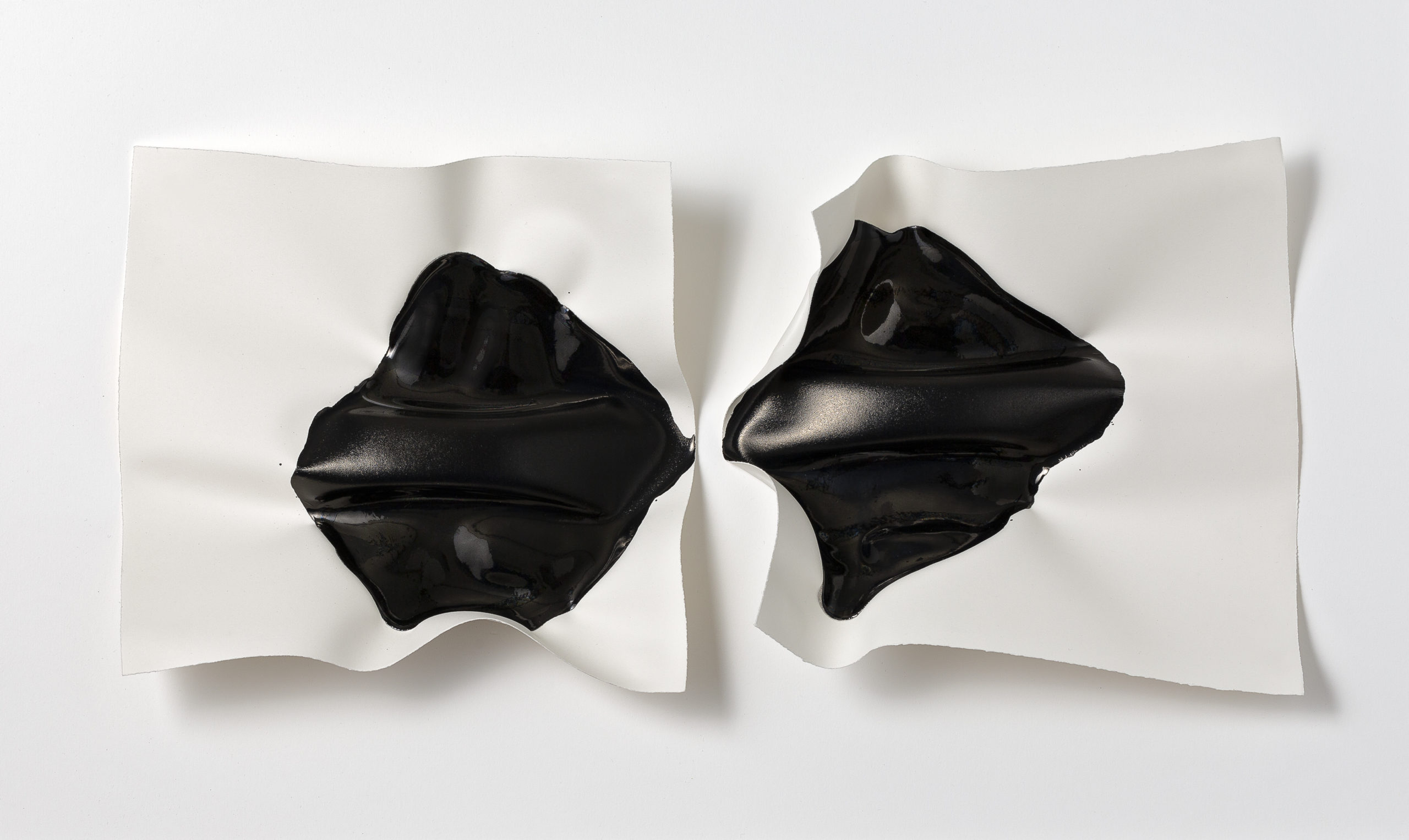
WHEN CONTEMPLATING THE universe, one wonders how it began its life. Science has supplied words about the universe and while the words have concrete meaning in the dictionary, it does not take long to arrive at the door of the abstract.
Details from the front include singularity, expansion, matter and energy, infinity and the many universes that may live alongside our own.
When contemplating the universe, one quickly arrives at a place that is uncertain and shifting. One accepts there are many interpretations about what lives in the gaps and silence.
When contemplating the universe, one begins by asking ‘how’ but realises the more interesting question is ‘why?’ And the why that we yearn for is at the heart of human curiosity as we seek to answer the unknowable, and ultimately that is: what is the meaning of life?
Dialogue
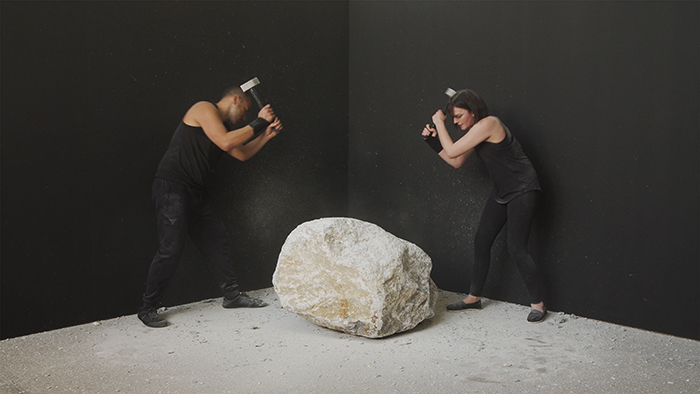
Emma Fielden, Dialogue, 2020, performance with limestone, HD video with sound, 6 hours 55 minutes, edition of 3 + 2AP. Performed by Emma Fielden and Tarik Ahlip. Filmed by Dara Gill. Commissioned by Parramatta Artists’ Studios Rydalmere for NEXT.
BEFORE MEETING EMMA Fielden, I made a list of questions, conscious of things I had been asked and how I did not wish to level those questions at another artist when we met face to face. I did not want to ask the usual questions about inspiration or secret meanings or what she meant when she did so-and-so. To try to pin down inspiration is to strip the process of its mystery, to force interpretation on work that has every desire not to be caged.
The question I most wanted to ask was what exactly was going through her mind. I wished to ask it after watching Dialogue, a seven-hour video in which Fielden and Tarik Ahlip try to break a rock. Of course I say try to break a rock but perhaps the work is about the act itself rather than an end result. Fielden begins with a hammer and brings it down, and then it is Ahlip’s turn, and there is a strange unity and harmony about the two of them and the rock that lies between them. The rock is limestone – as I later find out – and I wonder about the extremes of art, the desire to have the world pay attention while simultaneously trying to dissolve into a place where there is no voice, no individual, no future and no past and there is zero separation between the artist and her art.
A million things run through my mind watching the dialogue between the pair, watching the blackness of their clothes, the wall and the rock that separates the two hammerers to opposing sides. The million things bring me to The Myth of Sisyphus and Albert Camus: life is devoid of meaning, the natural response should be suicide, but on the other hand, it is up to us to give meaning to life. It is our meaning that we bring to the word, it is our meaning that we bring to an action, it is our meaning that watches forty minutes of Dialogue, wondering how it would feel to watch all seven hours, seeking extremes to shake off the routine encountered daily in life.
An extreme is climbing a mountain because a park pathway is not enough.
An extreme is a marathon viewing of Douglas Gordon’s 24 Hour Psycho (1994), the two-hour Alfred Hitchcock movie slowed to fit the twenty-four hours of a day.
An extreme is coming to a rock that is chipped at and to find, seven hours later, when the dialogue has ended, that between Fielden and Ahlip, the rock still stands.
An extreme is Sisyphus pushing his rock, bearing it like a cross to the mountain top only to have it roll down again, and the next day repeating the act.
An extreme is considering how to watch the physicality of Dialogue, two people taking turns – a physicality that later causes blisters to form on their hands, that leads people to question the safety of the performance, and Fielden’s response is: Do we think twice about the repetitive stress injuries that chip away slowly at the quality of our lives?
An extreme is desiring answers from the artist when the million thoughts are entirely in my own mind.
Zero
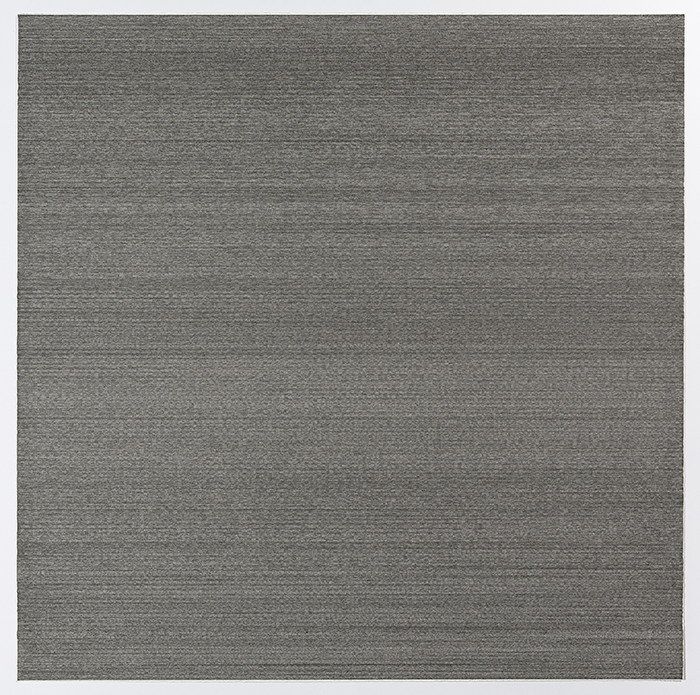
Emma Fielden, The Veil (after Renée Magritte’s The Lovers), 2020, pen and ink on Saunders Waterford 426gsm paper, 80x80cm. Photographed by Document Photography.
LONG AGO, WHEN the first people living on this continent contemplated the sky, they believed the ground they stood on was round at a time when elsewhere it was believed to be flat. The eye said it was flat but there was evidence that the eye might not be right. One looks to the stars in the night and they are round. One looks to the sun and here is our closest star and it is a circle that daily completes half a circle above our heads. Our nearest neighbour, the moon, has watched over us for millennia, and it is also a perfect circle in the night.
What then, except for the evidence of our eyes, impels us to hypothesise that the Earth is flat? The universe is populated with celestial bodies and the new ones we encounter in our explorations have every likelihood of also being round.
When representing life as a symbol, the circle makes more heart sense than any other shape. In answering what moves one to write or to paint, to methodically etch thousands of circles on a page, another symbol comes to mind: that of a snake chasing its tail. Before its central role in getting us flung out of paradise, the snake was synonymous with eternal life.
The circle is the zero and its interpretations are as endless as the ways we choose to represent a life. Infinity divided by anything is zero and both are not numbers but symbols to represent concepts that otherwise would dwarf our minds.
It is a zero, measured at a millimetre, that represents the barrier between two lovers, no matter how closely they touch. It is that zero that Fielden drew 800,000 times to create The Veil, aided by an architectural pen and a magnifying glass. These thousands of zeroes are lined up neatly, row upon row, and from a distance they create the effect of blurring lines. Up close, however, are the zeroes: individual, spaced, painstakingly arranged, the task of many months. The zeroes are framed in their final arrangement and so the separation between two human beings has been measured by Fielden exactly. It is a single millimetre that marks the end of one person and the beginning of the next life.
Performance
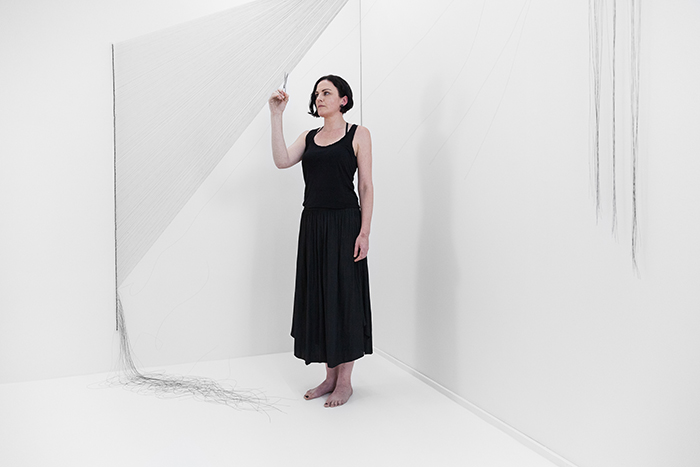
Emma Fielden, States of Matter, 2018, installation and performance with thread. Performed by Emma Fielden. Photographed by Docqment.
WHAT IS THE difference between performance and an act? Where does one begin, where exactly do we mark the end? The two share a blurry line. What draws one from sculpture to performance art? Is the performance the art or is art the later viewing by strangers after the performance has been taped?
2018 is the year that separates the art of before from the art that is made in the aftermath of Fielden’s residency in New York. She is there with her scissors, strings arranged above her head, reminiscent of a harp. Again there is neutrality, only white and black. These two are old friends and their pairing in States of Matter ensures the audience has no distractions from what Fielden has in mind.
She holds up her scissors and she cuts the threads one by one. In their fall is a symmetry, the half-threads swinging to opposing sides, and it is an act of music, although the video is conducted in silence. As the performance is recorded, there is greater emphasis on the threads falling to their final resting place when watched without any sound. The cutting is meditative, but this is not about action as a vehicle for meditation. In the absence of distractions (no colour, no sound, no props except the artist and her act), one zeroes in only on the performance and its meaning to the audience watching on.
In making any work and releasing it into the world, there is a peaceful acceptance that the work is then on its own. It has its own legs and it will find its audience or it will not. It is a submission to release a story and realise that to the writer it has one meaning, but readers will draw conclusions of their own. Even the writer will return later to the story and realise that the words have been loaded with meaning outside of her intentions when they were committed to the page. Later, when the work is in the world, one accepts that there is the work itself.
Then there are the infinite interpretations for the infinite views of the artist at work.
Material

Emma Fielden, Confluence, 2020, ink on Arches 300gsm paper, 740 x 445mm (framed). Photographed by Document Photography.
THE WRITER BEGINS her story in silence, her only materials paper and pen. The paper matters for its texture and the pen matters for its reliability because if it fails, she finds herself stranded, falling back to the fickle anchor of thoughts.
The artist begins her creation in silence. She has been thinking, researching, assembling, and she arrives at a place of choice. The choice relates to materials that will dictate the final boundaries of the work itself.
The choice of the writer relates to words. Each word committed to the page will dictate the limits of where the story ends up.
This is a time of possibility, the arrangement critical, because the artist and writer are both aware that the first commitment contains an echo of where the work will end. Materials are dismissed until a selection is made based on how well they express the artist’s thoughts.
For the performance of Dialogue, the artist requires a material that can be chipped at slowly and is sturdy – and therefore limestone is a natural choice.
The Veil requires a fine pen, fine enough to make a clean line that allows each circle to be separated from its neighbour. The circle is exact, repeated. It is measured by the artist at precisely a millimetre each time.
The threads of States of Matter are light but must have enough weight to fall gracefully and there is enough research and contemplation so the performance can be done in a single take.
Then there is the series of Confluence experiments with paper and ink. The ink is heavy, closer to paint, and it will distort the paper but it will not run through. The pattern will hold, it will be unique, and it will be an expression of an idea that has played on the artist’s mind for years.
Sometimes the idea arrives as a word. It is the first sound in a line that will run through the story until the writer reaches its end.
Sometimes the idea will be a pattern and the artist will eliminate possibilities before settling on an idea that is the ink she commits to the page.
Sometimes the idea arrives in the writer’s mind and she considers it for weeks before it is shaped on the page.
Sometimes the idea is a concept haunting the artist until she can assemble the materials that are the natural expression of the series of experiments with ink and paper so that the idea can finally rest and the artist can move to the idea that comes next.
Sometimes the idea is a concept in the mind of the artist and she trusts in the process of assembling materials that will best express the experiments with ink and paper she wishes to make.
Sometimes the writer will admit she takes her lines from art but all the while the artist in question took her lines from science.
Science
TO ARRIVE AT what moves us, what excites us is a subject best approached from the side. To encounter it directly is to force the magic that is shy to turn on its tail and find a place to hide. One can reference poetry, science, literature, sport, art, photography, but these words do not address the question and to mention them is a distraction, a comfortable way to pass the time.
There are countless references to science in Fielden’s work and it does not take long for the subject of science to come up between us.
I tell her that I wonder about the influence of science and its methodology on the words that I write.
She tells me that she has this great capacity for the ideas of physics and maths and many of her heroes are from the world of science.
I tell her about teaching science and the universe, how conversations in the classroom become philosophical, how one enters territory where uncertainty presides.
She tells me: I read, I study, I research, it takes me years to take the idea from its point of singularity to where it can expand endlessly out – silent, tangible – like the universe.
I tell her it interests me to break down barriers. Art meets literature meets science meets everything else.
She tells me about The Lovers, how she spent hours with Magritte’s painting in New York. She measures the distance between his lovers as a millimetre and this line is with me as I read Haruki Murakami’s Sputnik Sweetheart for a second time. To paraphrase Murakami: we are each satellites with our own orbit. Our orbit brings us closer, closer to each other, but there always remains Fielden’s distance, forever a millimetre apart.
We yearn for closeness but each of us is a universe and the answers we arrive at are ultimately our own private work.
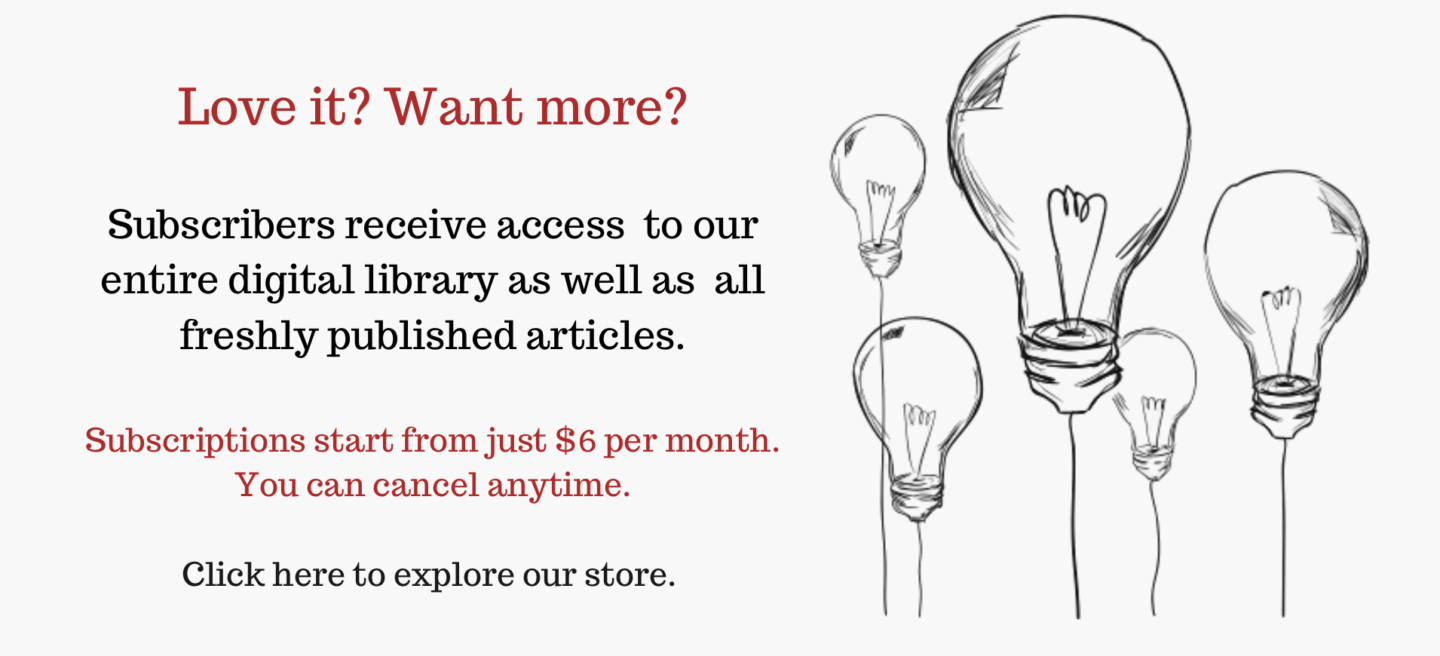
Share article
More from author

Gabrielle
GR OnlineTHIS IS MY address, Gabrielle, to you and to no one else. You are the person I wish to speak to about the tumult of recent weeks. Remember how I told you that when I have my first sentence and have weighed it, then I know I have my piece? I have my sentence now. I have my foundation, I have my structure, I have at last the language that will allow me to speak.